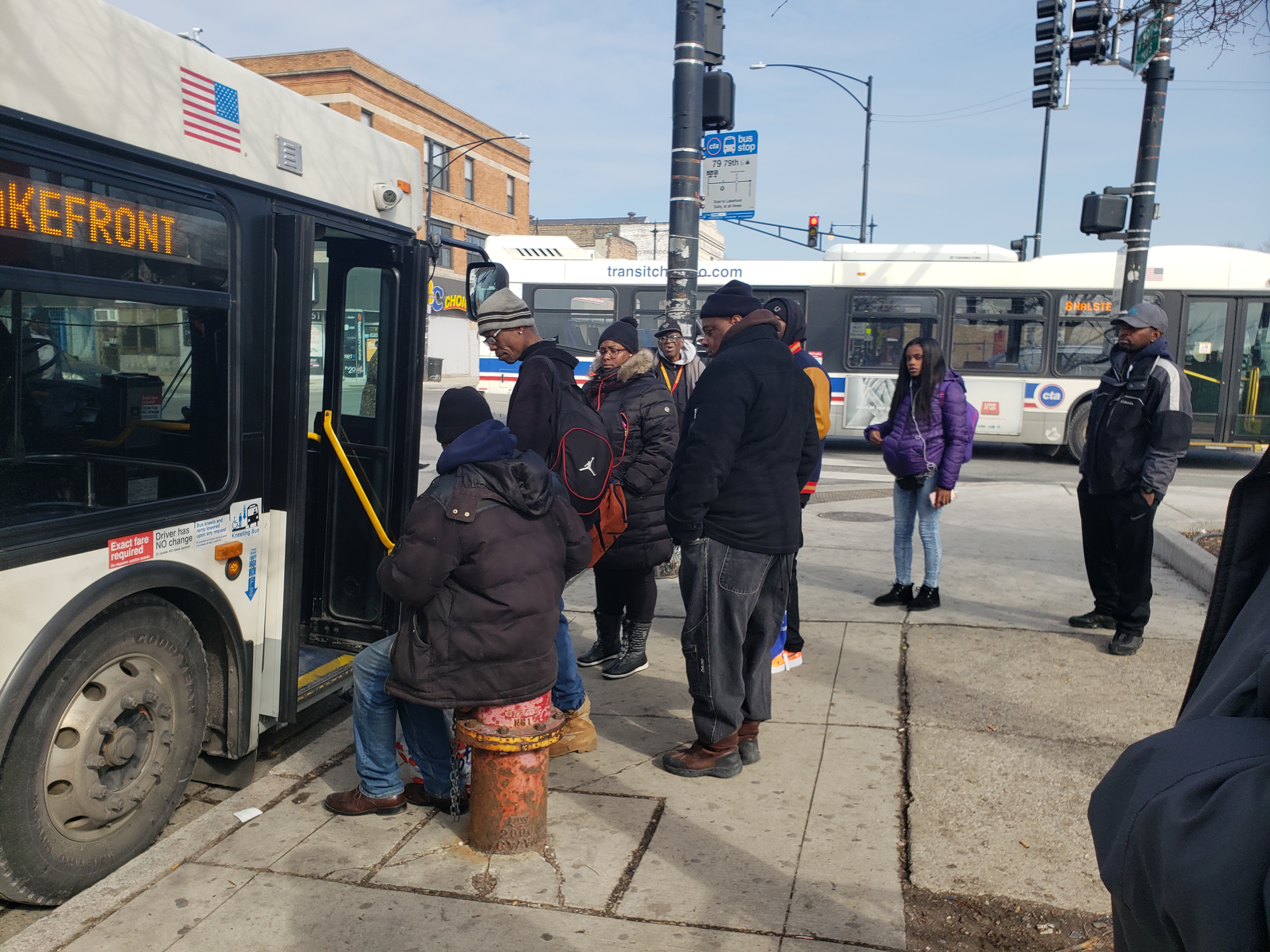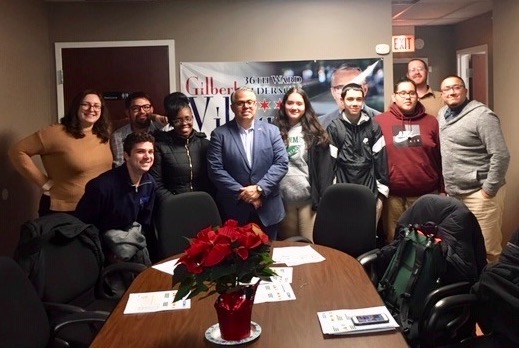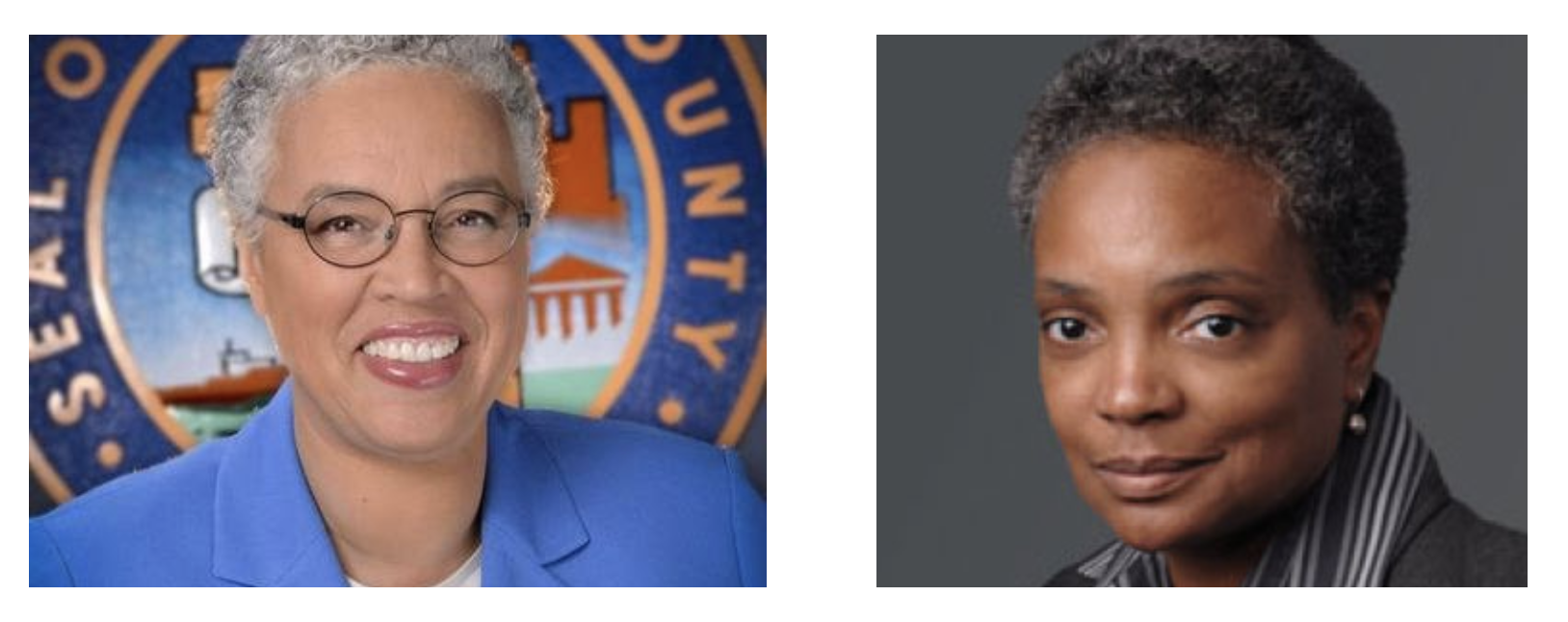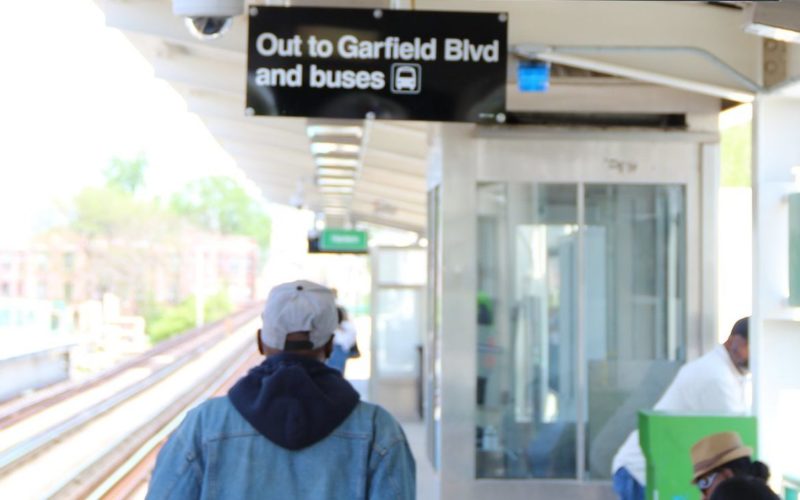
Riders wait to board the 79 bus on Chicago's South Side
Buses carry a majority of the Chicago Transit Authority’s trips, but ridership is eroding rapidly. Since 2012, bus ridership in Chicago is down 21 percent.
Despite the large number of Chicagoans who ride the bus, the quality of service tends not to draw much attention as a political issue. As this year’s elections for mayor and City Council approached, Active Trans aimed to change that.
Active Trans has spent the past several years raising awareness about the abysmal condition of Chicago’s buses through its “Back on the Bus” campaign. With funding from TransitCenter, the group kicked off the campaign in 2017 by publishing a report, Speeding Up Chicago’s Buses. In researching the report, Active Trans surveyed 1,000 people about why they weren’t riding the bus as often. The takeaway was that although the proliferation of Uber and Lyft played a role, the main factor was simply poor service.
“People said again and again it’s speed and reliability,” says Active Trans Advocacy Manager Julia Gerasimenko. “Average speeds have gone down nearly 1 mph since 2007. Bunching has gotten worse. We know that to get riders back, we have to improve the quality of service.”
Bus priority treatments such as bus-only lanes, transit signal priority, and all-door boarding are rare in Chicago. Chicago’s most visible application of these techniques has been limited to the central business district, where bus routes on the “Loop Link” operate in dedicated lanes with all-door level boarding at sheltered, elevated platforms.
Beyond Loop Link, neither the city nor the Chicago Transit Authority had made concrete commitments to additional bus improvements. The only transportation idea consuming political oxygen during the last few years of Rahm Emanuel’s mayoralty was a hyper-implausible Elon Musk proposal for high-speed, low-ridership underground express pods between the Loop and O’Hare.
With its Back on the Bus campaign, Active Trans focused on a different objective: improving transit for the many Chicagoans who live beyond the reach of the El’s hub-and-spoke network. The campaign is grounded in an evaluation of bus speeds and reliability based on publicly available data from the CTA.
ActiveTrans packaged the analysis in Bus Report Cards, grading service in every aldermanic ward and on the eight highest-ridership routes in the system. Cs and Ds were common.
To organize around better bus service, Active Trans teamed up with grassroots groups in five neighborhoods, gathering first-hand accounts from bus riders of how slow, unreliable service affects them. “Each group had their own organizing philosophy,” said Gerasimenko.
The Southwest Organizing Project, for instance, conducted 60 one-on-one interviews with bus riders. The Northwest Side Housing Center had its youth council take the lead, distributing surveys about bus service in English and Spanish, and presenting bus report cards to the local alderman. The Westside Health Authority interviewed laborers commuting before dawn on sparsely served routes – then shared their stories with the CTA Board.

Northwest Side Housing Center youth meeting their alderman
All told, Active Trans and its partners collected 600 surveys from bus riders.
Emanuel announced he wouldn’t be seeking another mayoral term last September. This created an opening for Active Trans to put ideas for bus improvements in front of the new crop of politicians who would be setting the city’s policy agenda.
Leading up to the February 2019 municipal election, Active Transportation NOW – a branch of the organization that engages in electoral politics — sent all 14 mayoral candidates questionnaires including an ask to commit to 50 miles of transit-priority streets. They also met one-on-one with the candidates. “To be able to show them the report cards was a great visual aid,” said Gerasimenko.
On January 15, Active Trans hosted a mayoral forum with the Pilsen Alliance, one of its neighborhood partners. Eight of the 14 candidates attended, including Lori Lightfoot, now competing with Toni Preckwinkle in the run-off election. “That showed them you can fill a room with people because they care about bus service,” said Gerasimenko, “and that was powerful.”

Toni Preckwinkle, left, and Lori Lightfoot will head into a run-off election April 2nd
With either Lightfoot or Preckwinkle headed to City Hall, the next mayor will be less focused on a fantasy tunnel to O’Hare, and more concerned with improving the bus service that hundreds of thousands of Chicagoans ride every day. Both candidates have endorsed the Active Trans target of adding 50 miles of transit priority streets.
“We can imagine a more exciting future for buses,” said Gerasimenko. “Service doesn’t have to be the crowded, late, unreliable experience we’ve all come to know and expect.”
 On the Brink: Will WMATA’s Progress Be Erased by 2024?
On the Brink: Will WMATA’s Progress Be Erased by 2024?
The experience of being a WMATA rider has substantially improved over the last 18 months, thanks to changes the agency has made like adding off-peak service and simplifying fares. Things are about to get even better with the launch of all-door boarding later this fall, overnight bus service on some lines starting in December, and an ambitious plan to redesign the Metrobus network. But all of this could go away by July 1, 2024.
Read More What’s Going on With Transit Service at the Seven Highest Ridership U.S. Cities? Chicago Edition
What’s Going on With Transit Service at the Seven Highest Ridership U.S. Cities? Chicago Edition
November 2021 marked a downward shift for service delivery at CTA, and the agency has not recovered as strongly as might have been expected, given its early-pandemic track record.
Read More